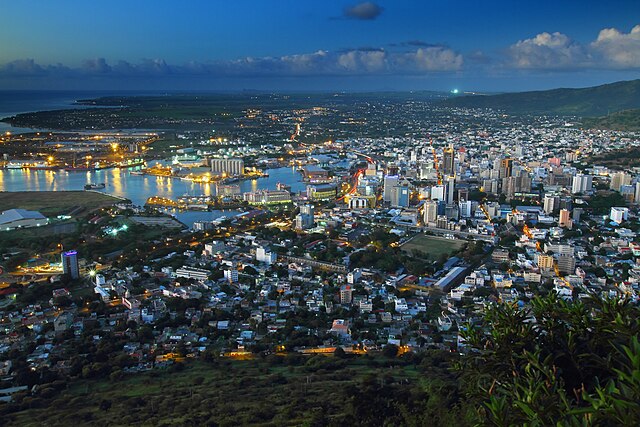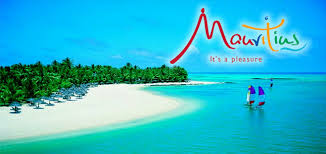Mauritius — an island nation world-renown for its lush, tropical vegetation, sugar cane plantations, dramatic mountains, sugar-white beaches, aquamarine lagoons and exotic mix of Indian, African, British, French, and Chinese cultural influence — is located in the Indian Ocean 500 miles east of Madagascar.

Trou-aux-Biches Beach in Mauritius. Photo by Romeodesign.
1. The country of Mauritius includes the island of Mauritius, Rodrigues and the outer islands (Agalega, St. Brandon, two disputed territories, and a number of smaller islands.)
2. The main island of Mauritius (called Mauritius) is only 28 miles wide and 40 miles long. It is of volcanic origin and is almost entirely surrounded by coral reefs.
3. Mark Twain wrote “Heaven was copied after Mauritius.”

Port Louis, the capital city of Mauritius, in the evening. Photo by Peter Kuchar (pkuchar).
4. Port Louis, both the capital and the largest city of Mauritius, was set up in 1736 by the French East India Company. The capital city is home to 40% of the national population.
5. Mauritius is home to some world-famous public beaches including the fun-named “Flic en Flac,” as well as Pereybere, Tamarin, Blue Bay, La Morne, Belle Mare, and Grand Bay.
6. Arab sailors first visited Mauritius during the Middle Ages, naming the island Dina Arobi.
7. In 1507, Portuguese navigator Diogo Fernandes Pereira was the first European to land in Mauritius. He named the island ‘Ilha do Cirne‘. The Portuguese did not stay long.
8. In 1598, a Dutch squadron landed in Mauritius at Grand Port under Admiral Wybrand Van Warwyck. He named the island “Mauritius” after Prince Maurice van Nassau, the ruler of the Dutch Republic.
9. The Dutch established a small colony on the island in 1638, introducing sugar cane, domestic animals and deer, but abandoned Mauritius in 1710.
10. France, which already controlled neighboring Île Bourbon (now Réunion Island), took control of Mauritius in 1715 and renamed it Isle de France.
11. French governor Bertrand-François Mahé de La Bourdonnais arrived in 1735. He established Port Louis as a naval base and a shipbuilding center, and oversaw the building of the Government house and the Line Barracks that still stand today.
12. Under the administration of the French East India Company, sugarcane plantations flourished and the island became an important base on the trade routes from Europe to the East before the opening of the Suez Canal.

The Battle of Grand Port in Mauritius between the France and England in 1810. Painting by artist Pierre Julien Gilbert.
13. Mauritius was part of the long power struggle between the French and the British during the Napoleonic Wars.
14. While the French won the Battle of Grand Port, they could not prevent the British from landing at Cap Malheureux three months later. France formally surrendered December 3, 1810, on terms allowing settlers to keep their land and property, the use of the French language, and the law of France in criminal and civil matters.
15. Under British rule, the island’s name reverted to Mauritius.
16. Slavery, key for the sugarcane plantations, was abolished in 1835. British planters brought in half a million indentured laborers from India to work in the sugar cane fields between 1834 and 1921.
17. Mauritius remained a strategically important British naval base, and later an air station, playing an important role during World War II for anti-submarine and convoy operations, as well as the collection of signal intelligence.
18. Mauritius attained its independence from the United Kingdom March 12, 1968.
19. The colorful national flag of Mauritius, also known as the “Four Bands, was adopted upon independence in 1968. It consists of red, blue, yellow and green bands representing:
-
-
- Red: the bloodshed at the time of slavery and colonization, or self-determination and independence.
- Blue: the Indian Ocean surrounding the island
- Yellow: the new light of independence shining, golden sunshine, or the bright future.
- Green: the lush vegetation of the island.
-
20. Mauritius is a democracy with its government elected every five years.
21. The currency of Mauritius is Mauritian Rupee (MUR). Currently, $1 US dollar is equal to 36.30 MUR (Mauritian rupees.)
22. Mauritian Creole is the primary language of 86.5 percent of residents Mauritians. Other languages include Bhojpuri (5.3%), French (4.1%), and English, (the official language, which is spoken by less than 1 percent of the population.) NOTE: this data is based on 2011 information from the CIA Factbook. A reader named Christelle says that most of the population (all but the elderly) speak three languages (English, French and Creole.) My friend James who traveled to the country confirmed that many hotel and other hospitality workers that he encountered speak some English, and communication was not a problem for the English-speaking traveler.)
23. Both English and French are generally accepted as the official languages of Mauritius and as the languages of government administration, courts, and business. The constitution of Mauritius is written in English, while some laws, such as the civil code, are in French.
24. Mauritius is a religiously diverse nation, with freedom of religion given as a constitutional right. Hinduism is the major religion claimed by 48.5 percent of residents, followed by Roman Catholic (26.3%), Muslim (17.3%), other Christian (6.4%).
25. Mauritius is the only African country to have a Hindu majority.
26. With a resident population estimated at 1,339,827 in 2015, Mauritius has the highest population density in Africa.
27. Since its independence in 1968, Mauritius has undergone a remarkable economic transformation from a low-income, agriculturally based economy to a diversified, upper middle-income economy based on sugar, tourism, textiles and apparel, and financial services, fish processing, information technology, and hospitality and property development.
28. Sugarcane is grown on about 90 percent of the cultivated land area in Mauritius, and accounts for 15 percent of the country’s export earnings. Tea, corn, potatoes, bananas, beans, cattle, goats and fish are other significant agricultural commodities produced in Mauritius.
29. Mauritius has a tropical climate with a warm humid summer from November to April, and a relatively cool dry winter from June to September. The average mean temperature is between 68 and 75 degrees F year round.
30. Mauritius was the only known habitat of the now-extinct dodo bird, a type of pigeon which settled on the island more than 4 million years ago. With no predators to attack them, dodos lost their need and ability to fly, and weighed up to 50 pounds.
31. After Portuguese sailors stopped in Mauritius in 1507, the island quickly became a stopover for ships engaged in the spice trade. The dodo was a welcome source of fresh meat for sailors, and a large number were killed for food. The Dutch introduced rats, pigs and monkeys to the island, all of which ate dodo eggs in the ground nests. Within 100 years of the arrival of humans on Mauritius, the once abundant dodo became a rare bird. The last one was killed in 1681.
32. The dodo is prominently featured in the Mauritius national Coat of Arms.
33. Lewis Carroll is said to have been inspired by the dodo to write his famous book “Alice in Wonderland” in 1865.
34. Seafood is a staple of Mauritian cuisine, which has Asian, Indian, French and British influences. Indians brought curries and chutney, while Chinese migrants made rice and noodles commonplace in Mauritius.

The Seven Colored Earths (Terres des Sept Couleurs) in the Chamarel Plain, Mauritius. Photo by Moongateclimber.
35. The Seven Colored Earths is a well-known tourist attraction at Chamarel in the southwest part of Mauritius. Visitors are enthralled by this geological formation of seven colors of sand that spontaneously settle in different layers, giving the dunes a surrealistic, striped appearance. These colorful sand dunes seemingly never erode, in spite of Mauritius’ torrential, tropical rains.
36. Hikers won’t want to miss a visit to Black River Gorges National Park for stunning views in the hilly south-western part of Mauritius. The park protects most of the island’s remaining rain forest and unique species such as the Mauritian Pink Pigeon, one of the world’s rarest birds.
37. Sega music – originated among the slave populations of Mauritius – is now considered the national music of Mauritius. When performing the sega folk dance, Mauritian dancers move their entire body but their feet never leave the ground.
38. Mauritius boxer Bruno Julie won his country’s first Olympic medal by taking the bronze at the 2008 Summer Olympics in Beijing.
39. The main international airport in Mauritius is located southeast of Port Louis, and has a long name. It is the Sir Seewoosagur Ramgoolam International Airport with airport code MRU.
40. While the ultramodern Christian Decotter Cruise Terminal was built in Port Louis to accommodate the world’s largest cruise ships, there are only about 25 port calls to the island each year, mainly on longer cruises. Costa, MSC, Princess, Silver Sea, Cunard, P & O and Crystal are among the cruise lines with scheduled calls to Port Louis in 2016 and 2017.



